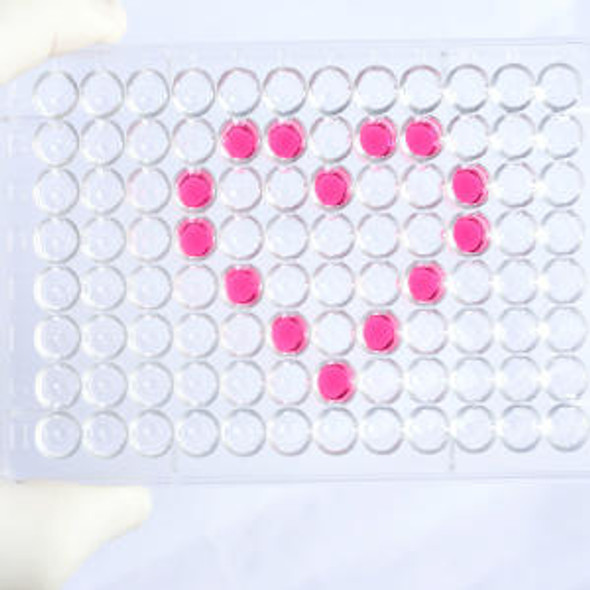Human S100A7 (S100 Calcium Binding Protein A7) ELISA Kit (HUES02352)
- SKU:
- HUES02352
- Product Type:
- ELISA Kit
- Size:
- 96 Assays
- Uniprot:
- P31151
- Sensitivity:
- 0.09ng/mL
- Range:
- 0.16-10ng/mL
- ELISA Type:
- Sandwich
- Synonyms:
- Protein S100-A7, PSOR1, S100A7c, Psoriasin
- Reactivity:
- Human
- Sample Type:
- Serum, plasma and other biological fluids
- Research Area:
- Cell Biology
Description
Human S100A7 (S100 Calcium Binding Protein A7) ELISA Kit
The Human S100A7 (S100 Calcium Binding Protein A7) ELISA Kit is specifically designed to accurately measure S100A7 levels in human serum, plasma, and cell culture supernatants. This ELISA kit offers high sensitivity and specificity, ensuring dependable and consistent results for a variety of research purposes.S100A7 is a calcium-binding protein that plays a crucial role in inflammatory processes and skin diseases.
It is implicated in conditions such as psoriasis, atopic dermatitis, and certain types of cancer, making it a valuable biomarker for studying these diseases and developing targeted treatments.Overall, the Human S100A7 ELISA Kit provides researchers with a reliable tool to quantitatively measure S100A7 levels and further understand its role in health and disease.
| Assay type: | Sandwich |
| Format: | 96T |
| Assay time: | 4.5h |
| Reactivity: | Human |
| Detection Method: | Colormetric |
| Detection Range: | 0.16-10 ng/mL |
| Sensitivity: | 0.10 ng/mL |
| Sample Volume Required Per Well: | 100µL |
| Sample Type: | Serum, plasma and other biological fluids |
| Specificity: | This kit recognizes Human S100A7 in samples. No significant cross-reactivity or interference between Human S100A7 and analogues was observed. |
This ELISA kit uses Sandwich-ELISA as the method. The micro ELISA plate provided in this kit has been pre-coated with an antibody specific to Human S100A7. Standards or samples are added to the appropriate micro ELISA plate wells and combined with the specific antibody. Then a biotinylated detection antibody specific for Human S100A7 and Avidin-Horseradish Peroxidase (HRP) conjugate are added to each micro plate well successively and incubated. Free components are washed away. The substrate solution is added to each well. Only those wells that contain Human S100A7, biotinylated detection antibody and Avidin-HRP conjugate will appear blue in color. The enzyme-substrate reaction is terminated by adding Stop Solution and the color turns yellow. The optical density (OD) is measured spectrophotometrically at a wavelength of 450 nm ± 2 nm. The OD value is proportional to the concentration of Human S100A7. The concentration of Human S100A7 in samples can be calculated by comparing the OD of the samples to the standard curve.
| UniProt Protein Function: | S100A7: is a member of the S100 family of proteins containing 2 EF-hand calcium-binding motifs. S100 proteins are localized in the cytoplasm and/or nucleus of a wide range of cells, and involved in the regulation of a number of cellular processes such as cell cycle progression and differentiation. S100 genes include at least 13 members which are located as a cluster on chromosome 1q21. This protein differs from the other S100 proteins of known structure in its lack of calcium binding ability in one EF-hand at the N-terminus. This protein is markedly over-expressed in the skin lesions of psoriatic patients, but is excluded as a candidate gene for familial psoriasis susceptibility. The exact function of this protein is not known. [provided by RefSeq, Jul 2008] |
| UniProt Protein Details: | Chromosomal Location of Human Ortholog: 1q21 Cellular Component: focal adhesion; endoplasmic reticulum; cytoplasm; extracellular region; nucleus; cytosol Molecular Function:RAGE receptor binding; protein binding; zinc ion binding; calcium ion binding Biological Process: keratinocyte differentiation; sequestering of metal ion; response to reactive oxygen species; epidermis development; innate immune response; response to lipopolysaccharide; angiogenesis; defense response to Gram-negative bacterium |
| NCBI Summary: | The protein encoded by this gene is a member of the S100 family of proteins containing 2 EF-hand calcium-binding motifs. S100 proteins are localized in the cytoplasm and/or nucleus of a wide range of cells, and involved in the regulation of a number of cellular processes such as cell cycle progression and differentiation. S100 genes include at least 13 members which are located as a cluster on chromosome 1q21. This protein differs from the other S100 proteins of known structure in its lack of calcium binding ability in one EF-hand at the N-terminus. The protein is overexpressed in hyperproliferative skin diseases, exhibits antimicrobial activities against bacteria and induces immunomodulatory activities. [provided by RefSeq, Nov 2014] |
| UniProt Code: | P31151 |
| NCBI GenInfo Identifier: | 172046820 |
| NCBI Gene ID: | 6278 |
| NCBI Accession: | P31151. 4 |
| UniProt Secondary Accession: | P31151,Q5SY67, Q6FGE3, Q9H1E2, |
| UniProt Related Accession: | P31151 |
| Molecular Weight: | 101 |
| NCBI Full Name: | Protein S100-A7 |
| NCBI Synonym Full Names: | S100 calcium binding protein A7 |
| NCBI Official Symbol: | S100A7 |
| NCBI Official Synonym Symbols: | PSOR1; S100A7c |
| NCBI Protein Information: | protein S100-A7; psoriasin 1; S100 calcium-binding protein A7 (psoriasin 1) |
| UniProt Protein Name: | Protein S100-A7 |
| UniProt Synonym Protein Names: | Psoriasin; S100 calcium-binding protein A7 |
| Protein Family: | Protein |
| UniProt Gene Name: | S100A7 |
| UniProt Entry Name: | S10A7_HUMAN |
As the OD values of the standard curve may vary according to the conditions of the actual assay performance (e. g. operator, pipetting technique, washing technique or temperature effects), the operator should establish a standard curve for each test. Typical standard curve and data is provided below for reference only.
| Concentration (ng/mL) | O.D | Average | Corrected |
| 10 | 2.42 2.424 | 2.422 | 2.34 |
| 5 | 1.691 1.703 | 1.697 | 1.615 |
| 2.5 | 0.951 0.923 | 0.937 | 0.855 |
| 1.25 | 0.453 0.469 | 0.461 | 0.379 |
| 0.63 | 0.28 0.258 | 0.269 | 0.187 |
| 0.32 | 0.196 0.172 | 0.184 | 0.102 |
| 0.16 | 0.124 0.144 | 0.134 | 0.052 |
| 0 | 0.075 0.089 | 0.082 | -- |
Precision
Intra-assay Precision (Precision within an assay): 3 samples with low, mid range and high level Human S100A7 were tested 20 times on one plate, respectively.
Inter-assay Precision (Precision between assays): 3 samples with low, mid range and high level Human S100A7 were tested on 3 different plates, 20 replicates in each plate.
| Intra-assay Precision | Inter-assay Precision | |||||
| Sample | 1 | 2 | 3 | 1 | 2 | 3 |
| n | 20 | 20 | 20 | 20 | 20 | 20 |
| Mean (ng/mL) | 0.48 | 1.21 | 4.69 | 0.50 | 1.20 | 4.89 |
| Standard deviation | 0.03 | 0.06 | 0.20 | 0.03 | 0.06 | 0.20 |
| C V (%) | 6.25 | 4.96 | 4.26 | 6.00 | 5.00 | 4.09 |
Recovery
The recovery of Human S100A7 spiked at three different levels in samples throughout the range of the assay was evaluated in various matrices.
| Sample Type | Range (%) | Average Recovery (%) |
| Serum (n=5) | 83-95 | 90 |
| EDTA plasma (n=5) | 86-97 | 91 |
| Cell culture media (n=5) | 89-101 | 95 |
Linearity
Samples were spiked with high concentrations of Human S100A7 and diluted with Reference Standard & Sample Diluent to produce samples with values within the range of the assay.
| Serum (n=5) | EDTA plasma (n=5) | Cell culture media (n=5) | ||
| 1:2 | Range (%) | 84-98 | 92-104 | 91-104 |
| Average (%) | 90 | 98 | 97 | |
| 1:4 | Range (%) | 93-107 | 84-94 | 88-100 |
| Average (%) | 99 | 89 | 94 | |
| 1:8 | Range (%) | 90-106 | 81-93 | 84-97 |
| Average (%) | 97 | 87 | 90 | |
| 1:16 | Range (%) | 88-99 | 82-94 | 88-102 |
| Average (%) | 94 | 87 | 94 |
An unopened kit can be stored at 4°C for 1 month. If the kit is not used within 1 month, store the items separately according to the following conditions once the kit is received.
| Item | Specifications | Storage |
| Micro ELISA Plate(Dismountable) | 8 wells ×12 strips | -20°C, 6 months |
| Reference Standard | 2 vials | |
| Concentrated Biotinylated Detection Ab (100×) | 1 vial, 120 µL | |
| Concentrated HRP Conjugate (100×) | 1 vial, 120 µL | -20°C(shading light), 6 months |
| Reference Standard & Sample Diluent | 1 vial, 20 mL | 4°C, 6 months |
| Biotinylated Detection Ab Diluent | 1 vial, 14 mL | |
| HRP Conjugate Diluent | 1 vial, 14 mL | |
| Concentrated Wash Buffer (25×) | 1 vial, 30 mL | |
| Substrate Reagent | 1 vial, 10 mL | 4°C(shading light) |
| Stop Solution | 1 vial, 10 mL | 4°C |
| Plate Sealer | 5 pieces | |
| Product Description | 1 copy | |
| Certificate of Analysis | 1 copy |
- Set standard, test sample and control (zero) wells on the pre-coated plate and record theirpositions. It is recommended to measure each standard and sample in duplicate. Note: addall solutions to the bottom of the plate wells while avoiding contact with the well walls. Ensuresolutions do not foam when adding to the wells.
- Aliquot 100 µL of standard solutions into the standard wells.
- Add 100 µL of Sample / Standard dilution buffer into the control (zero) well.
- Add 100 µL of properly diluted sample (serum, plasma, tissue homogenates and otherbiological fluids) into test sample wells.
- Cover the plate with the sealer provided in the kit and incubate for 90 min at 37 °C.
- Aspirate the liquid from each well, do not wash. Immediately add 100 µL of BiotinylatedDetection Ab working solution to each well. Cover the plate with a plate seal and gently mix. Incubate for 1 hour at 37 °C.
- Aspirate or decant the solution from the plate and add 350 µL of wash buffer to each welland incubate for 1-2 minutes at room temperature. Aspirate the solution from each well andclap the plate on absorbent filter paper to dry. Repeat this process 3 times. Note: a microplatewasher can be used in this step and other wash steps.
- Add 100 µL of HRP Conjugate working solution to each well. Cover with a plate seal andincubate for 30 min at 37 °C.
- Aspirate or decant the solution from each well. Repeat the wash process for five times asconducted in step 7.
- Add 90 µL of Substrate Reagent to each well. Cover with a new plate seal and incubate forapproximately 15 min at 37 °C. Protect the plate from light. Note: the reaction time can beshortened or extended according to the actual color change, but not by more than 30min.
- Add 50 µL of Stop Solution to each well. Note: Adding the stop solution should be done inthe same order as the substrate solution.
- Determine the optical density (OD value) of each well immediately with a microplate readerset at 450 nm.






